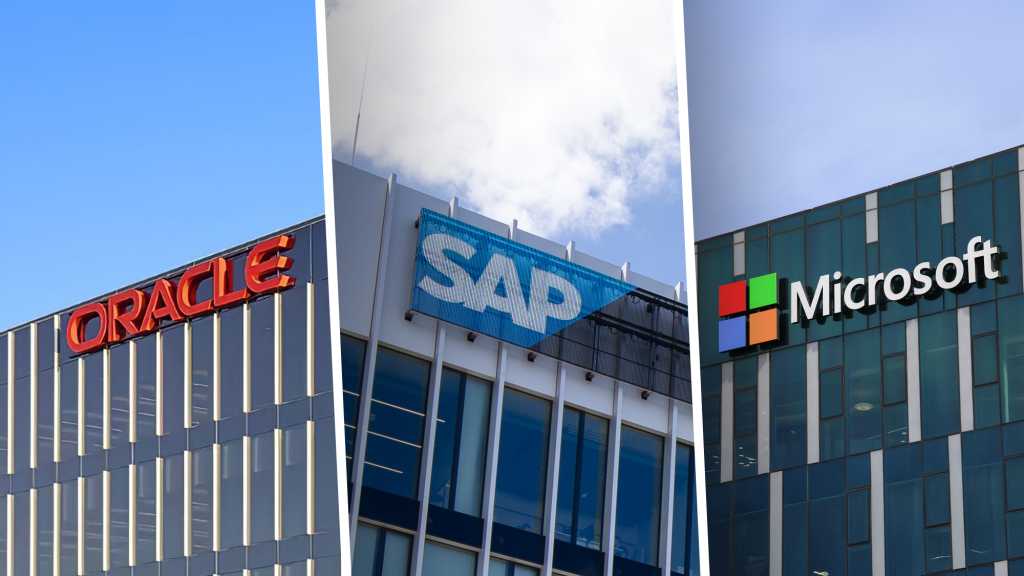AI is reshaping the enterprise resource planning (ERP) landscape, as vendors seek to harness the technology to help their customers improve operations, achieve efficiencies, and innovate.

The market for ERP systems has been relatively stable over the past several years, but AI is changing everything. Vendors are racing to embed AI functionality across their product portfolios and building out an ecosystem that includes composable applications, centralized data stores, and scalable cloud platforms.
On AI for ERP, Robert Kramer, an analyst at Moor Insights and Strategy, says, “We’ve moved past the experimental phase into practical use, where AI will manage entire workflows within ERP and supply chain systems. A key driver of this transformation is AI agents, which can handle more sophisticated tasks and end-to-end processes, even engaging in automated decision-making.”
IDC, in its FutureScape: Worldwide Intelligent ERP 2025 Predictions, adds, “This deep integration of AI into business processes heralds a new era of enterprise optimization, where the line between human and machine capabilities will become increasingly blurred, pushing the boundaries of what is possible in business efficiency and innovation.”
Seismic shakeups to the ERP vendor pecking order may already be happening. According to analysis from research firm Apps Run the World, Oracle has surpassed longtime frontrunner SAP in annual ERP revenue, $8.7B to $8.6B. And Acumatica was just snapped up by a private equity firm, which many trigger consolidation among midmarket ERP vendors.
In any event, our power rankings aren’t based solely on numbers. Innovation, strategy, alliances, AI capabilities, momentum, and mojo all enter into the equation. Here are the 10 most powerful ERP vendors today.
1. Oracle: Big bets on AI pay off with revenue surge
Why they’re here: Oracle is perfectly positioned to excel in the highly competitive race to deliver AI-based functionality to ERP customers. The company has the trifecta: its own database, its own cloud, and the two-headed monster of Fusion Cloud ERP for large enterprises and NetSuite ERP for SMBs. Chairman and CTO Larry Ellison described Oracle’s advantage this way: “These other companies say they have all the data, so they can do AI really well. They can build all these AI agents on top of all of that data. The only problem with that statement is they don’t have all the data. We do. The vast majority of it is in an Oracle database.” He adds, “We are the key enabler for enterprises to use their own data and AI models. No one else is doing that.”
Power moves: Oracle is a key player in the Stargate Project, a $500B effort to build an AI infrastructure in the US.
By the numbers: $132,500: Oracle averages $132,500 in revenue per customer, compared to $91,800 for SAP, according to Apps Run the World.
Outlook: Oracle CEO Safra Catz predicts that total cloud growth (applications plus infrastructure) will increase 40% in fiscal 2026, and cloud infrastructure will skyrocket 70%. She adds, “Oracle is well on its way to being not only the world’s largest cloud application company — but also one of the world’s largest cloud infrastructure companies.”
2. SAP: Restructured, rejuvenated, and reaping the rewards
Why they’re here: Any suggestion that the longtime ERP leader is slipping has been dispelled by its latest earnings report, which shows SAP’s cloud ERP suite revenue up 34%, cloud revenue up $27%, total revenue up $12%, and operating profit up 60%. Gartner says SAP is a leader in ERP systems for product-centric companies. And SAP is innovating around AI, with its Joule AI copilot that delivers real-time recommendations to end users. SAP says that Joule may be able to influence as much as 80% of common user tasks, potentially increasing productivity by 20%.
Power moves: SAP is working with competitor Microsoft to help migrate its on-prem customers to Microsoft’s Azure cloud. SAP has also forged a sweeping partnership with data-engineering powerhouse Databricks.
By the numbers: 55.4%: SAP says that cloud revenue has inched past the 50/50 mark and is now 55.4% of total revenue, as it migrates legacy customers off on-prem systems.
Outlook: “The first quarter shows once again that our formula for success is working,” said CEO Christian Klein. After a restructuring that slashed 10,000 jobs, SAP says it expects 2025 cloud revenue to surge from €17B to nearly €22B, a jump of around 25%. Bob Evans, an industry analyst at Cloud Wars, adds, “I view SAP’s highly differentiated performance in growth rates — a trend that’s held strong for the past several quarters — versus those of its competitors as a clear indication that SAP has established itself as the clear leader in the wickedly competitive enterprise-apps space.”
3. Microsoft: All-in on agentic AI
Why they’re here: Microsoft might not have the deep vertical industry knowledge of some other ERP vendors, but it has a host of advantages: its own cloud (Azure), a partnership with OpenAI that has provided a significant head start when it comes to delivering AI capabilities (Copilot), and a longstanding relationship with enterprises who are already running Microsoft productivity (Office 365) and business intelligence tools (Power BI).
Power moves: Microsoft says it plans to spend $80B in fiscal 2025 on construction of data centers that can handle artificial intelligence workloads.
By the numbers: 16%: In its most recent quarter, Microsoft announced that Dynamics products and cloud services revenue increased 11%, driven by Dynamics 365 revenue growth of 16%.
Outlook: CEO Satya Nadella recently announced a major reorganization focused on agentic AI. Natella said, “As we build out the next phase of the agentic web, we have a tremendous opportunity to transform every role, business process, and industry. To that end, we are bringing together LinkedIn, Microsoft 365, and Dynamics 365 to redefine and to drive these new Al solutions.” Patrick Moorhead, CEO of Moor Insights & Strategies, says, “This is big and is about the ‘SaaS is dead’ narrative we’ve heard from Satya Nadella. Microsoft believes so strongly that SaaS is dead and agents are the future that it is combining agents with business and office productivity applications in one group.”
4. Workday: Taking a targeted approach to AI
Why they’re here: Workday is a cloud-native leader in service-centric ERP, which focuses on HR, human capital management (HCM), finance, and accounting. Gartner says one of Workday’s major strengths is its unified data core, which is “fully harmonized across its ERP suite and enhances its built-in analytics and AI capabilities.” Whereas other vendors are spitting out scores of AI agents as fast as they can, Workday is taking a different approach, intentionally releasing less than 10 Illuminate agents. Workday says many customers are unsure about how to get the most ROI from agentic AI and are overwhelmed by so many options. Workday’s approach is quality over quantity — and not getting too far ahead of its customers.
Power moves: Workday bought Evisort, a leading AI-native document intelligence platform. With Evisort, Workday will add AI-powered document intelligence solutions across its finance and HR suite.
By the numbers: 12.6%: Workday’s first quarter fiscal 2026 results were impressive: a 12.6% increase in revenue and a 13.4% increase in subscription revenue.
Outlook: “Workday is an ambitious, well run, culture-driven company,” says industry analyst Josh Bersin. “Workday is banking on a few big bets: aggressive partnerships and industry solutions, building agentic AI, investment in Workday Financials, and a midmarket offering.” He adds, “With a new CTO and strong focus on global growth, I see no reason Workday can’t achieve its $10 billion target in the next three to four years.”
5. IFS: A clear vision for AI
Why they’re here: IFS is a company on the move. The only vendor listed as a “visionary” in Gartner’s most recent analysis of product-centric ERP companies, AI is the key driver. Gartner says, “Recent innovations include AI capabilities in cash flow simulations and system-generated alternate shipping routing to avoid acute disturbances. Future innovation is centered around bringing further AI and sustainability features to customers.”
Power moves: In April, IFS launched IFS Nexus Black, a program designed to accelerate the adoption of high-impact AI capabilities for industrial organizations by partnering with customers to address their specific challenges and turn ideas into outcomes.
By the numbers: 30%: Annual recurring revenue rose 30% year-over-year in first quarter 2025 earnings, with cloud revenue up 39%.
Outlook: The company reports that “customer demand for IFS’s industrial application of generative and agentic AI is soaring, thanks to the ease of which IFS.ai can be adopted and deployed, as well as the rapid value it delivers. IFS customers are not simply piloting AI, they are operationalizing it at scale, unlocking productivity, business resilience, and strategic growth.” IDC analyst Aly Pinder adds, “IFS has strength in the breadth of service capabilities that incorporate AI, machine learning, and IoT.”
6. Infor: GenAI tailored to specific verticals
Why they’re here: IDC puts Infor in the leader category in its MarketScape for Worldwide SaaS and Cloud-Enabled Large Enterprise ERP applications. Infor’s cloud ERP solutions deliver industry-specific capabilities without extensive customizations or integrations by combining the Infor cloud platform built on Amazon Web Services (AWS) and Infor OS innovation services. On the AI front, Infor GenAI embeds workflows across the Infor CloudSuite ecosystem to help transform operations, improve efficiency, and uncover new insights.
Power moves: Infor announced a new partnership with Kinaxis, a leader in supply chain orchestration. A newly released product, Kinaxis Planning One for Infor CloudSuite, will provide advanced supply chain orchestration for Infor manufacturing customers.
By the numbers: 60,000: Infor boasts more than 60,000 customers in over 175 countries.
Outlook: Infor is banking on its 30-plus years of industry knowledge to deliver “micro-verticalization” within broad industries, including automotive, food and beverage, retail supply chain, chemicals, industrial manufacturing, and warehouse management. Infor is also investing heavily in AI capabilities, which are delivered through its Velocity Suite, which combines process mining, AI, and robotic process automation.
7. QAD: New AI assistant, new CEO
Why they’re here: QAD is a manufacturing-focus CRM vendor that is taking an aggressive approach to embedding AI functionality across its portfolio. In 2023, QAD bought Redzone, an AI-powered connected workforce platform. More recently, QAD introduced Champion AI, an AI agent designed to empower workers by providing actionable insights and proactive problem-solving tools, connecting enterprise systems such as ERP, manufacturing execution systems (MES), and supply chain management (SCM). “Champion AI represents our commitment to practical AI solutions that assist workers in achieving higher productivity, not by overwhelming or replacing them with technology but by acting as an accessible, intelligent assistant,” said Ron Davis, senior vice president of product engineering at QAD Redzone.
Power moves: In May, QAD announced a partnership with Boomi, a leader in AI-driven automation. QAD says that combining Boomi’s best-in-class integration platform with QAD’s deep manufacturing expertise and Champion AI-driven insights, will help manufacturers simplify complexity and accelerate performance.
By the numbers: 1,300: The number of global manufacturing plants using QAD Redzone.
Outlook: On March 17, QAD announced that longtime CEO Anton Chilton was stepping down and Sanjay Brahmawar, formerly CEO at Software AG, is taking the helm. Brahmawar brings a strong background in transformation and customer-centric leadership. “Sanjay joins QAD at a pivotal time in its journey,” said Charles Goodman, chairman of the QAD board of directors and Thoma Bravo Operating Partner. “His expertise in innovation and his strong sense of customer needs make him the perfect choice to lead us forward.”
8. Epicor: Bringing the power of AI to midsize manufacturers
Why they’re here: Epicor, which targets midsize organizations, is a leader in Gartner’s latest analysis of ERP vendors in product-centric industries with its industry-specific packages such as Kinetic for manufacturers and Prophet 21 for distributors. Gartner adds, “The future roadmap emphasizes AI innovation, focusing on the cognitive ERP concept of ‘data to action’ and sustainability development.” Epicor also excels with its “data as a service” (DaaS) approach to enabling data sharing within enterprises and its low-code integration workbench, Automation Studio.
Power moves: Epicor recently announced the availability of enhancements to Epicor Prism, a network of vertical AI agents designed for supply chain industries, as well as new predictive machine learning (ML) capabilities in its Grow AI, a predictive AI modeling engine, which runs on the firm’s Grow Data Platform.
By the numbers: $2.6B. Privately held Epicor keeps its financials close to the vest, but CEO Steve Murphy recently said his team is planning to double sales of its enterprise software to $2.6 billion over the next four years.
Outlook: “Epicor is putting its R&D efforts into AI and data management. It is great to see overall,” said Mickey North Rizza, group vice president of enterprise software at analyst firm IDC, noting that research shows that 25% of organizations plan to replace their current application provider if generative AI won’t be included in its offering.
9. Acumatica: Acquisition could trigger midmarket ERP wars
Why they’re here: IDC has positioned Acumatica in its leader category in its 2024 IDC MarketScape for Worldwide SaaS and Cloud-Enabled Medium-sized Business ERP applications. Acumatica’s consumption-based licensing model is unique. And Acumatica’s flexible deployment options enable customers to operate Acumatica as a SaaS instance on AWS, as a private instance on the customer’s own cloud, or as a hybrid. As for its AI strategy, Chief Product Officer Ali Jani says, “While others rush AI to market to serve their interests, we focus on capabilities that solve real-world problems.” Acumatica’s AI strategy revolves around AI as an intelligent advisor, AI-driven automation and interactive AI assistants.
Power moves: On May 29, Acumatica announced that it is being acquired by Vista Equity Partners, a global investment firm. Terms were not disclosed.
By the numbers: 10,000: IDC puts the total number of Acumatica clients at 10,000.
Outlook: Acumatica CEO John Case said, “Our partnership with Vista not only marks a significant milestone in Acumatica’s history but also is a strong endorsement of the real-world value we deliver to the market and our customers. With Vista’s support, we believe we’re positioned to accelerate product development, deepen partner engagement, and extend our impact.”
Monti Saroya, co-head of Vista’s Flagship Fund, adds, “Acumatica is an ascendant, cloud-native ERP platform. We believe Acumatica is well-positioned to lead the shift toward modern, integrated ERP solutions.”
10. Sage: Focused on getting AI right, not necessarily first
Why they’re here: Sage has a strong, varied product line that includes Sage Intacct, a fully managed cloud solution for accounting and financial management that is targeted at small to midmarket organizations, plus Sage X3, which can be either on-prem or cloud, and is a more comprehensive ERP package that includes manufacturing, supply chain, and inventory management.
Power moves: At its Sage Future conference in early June, the company announced Sage Copilot for X3, an AI tool designed to targets sales intelligence in manufacturing and distribution. The tool enables organizations to use natural language queries to anticipate disruptions, optimize real-time decisions, and elevate customer service.
By the numbers: 9%: Half-year results show revenue growth of 9%, with operating profit margin increasing to 23.2%.
Outlook: Sage is taking a measured approach to AI. It is fully embracing the technology, but making sure that it doesn’t get too far ahead of its SMB customers. Dan Miller, EVP of ERP and finance, says that Sage is focused on a human-centric approach to AI that delivers capabilities to people that provide measurable value. “One of the things people are still not quite getting right is they’re feeling the pressure to adopt AI rapidly,” Miller says, “but, we have to get it right, not be first. There’s a high risk of getting it wrong.”










